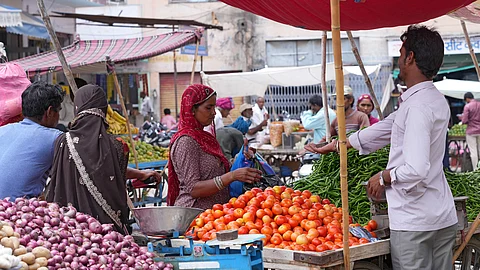

Over the past two years, India’s food inflation rate has remained firm at 8.8 per cent, diverging from global trends of stability and even a decline. The recently concluded Economic Survey 2024-25 has attributed this higher than expected food inflation to adverse weather conditions and supply chain disruptions.
The Economic Survey 2024-25, tabled by Union Finance Minister Nirmala Sitharaman today, on January 31, 2025, found that India’s overall retail inflation moderated from 5.4 per cent in Financial Year (FY) 2024 to 4.9 per cent in FY25 (April-December).
Food items constitute about two-fifths of the consumer price index in India and hence the Consumer Food Price Index (CFPI) is a significant determinant of retail inflation.
However, there has been a debate about reducing the weightage of food in the consumer price index (CPI) basket to address inflation concerns.
The domestic food inflation, as per the Economic Survey, was primarily driven by a few food items such as vegetables and pulses.
Vegetables and pulses together hold a total weightage of 8.42 per cent in CPI basket. However, their contribution to the overall inflation stood at 32.3 per cent in FY25 (April to December).
When these items are excluded, the average food inflation rate for FY25 (April-December) was 4.3 per cent, which is 4.1 per cent lower than the overall food inflation.
Similarly, the average headline inflation would be 3.2 per cent when the vegetables and pulses inflation rate were excluded, 1.7 per cent lower than the actual headline inflation.
Food inflation driven by vegetables and pulses
The Survey pointed out that the three most price sensitive vegetables were tomato, onion and potato (TOP) and that tomato and onion prices specifically have been drivers of food inflation, and consequently headline inflation in recent months.
The report, however, indicated that supply chain disruption caused by adverse weather conditions are responsible for the firm food inflation.
Analysis of production and consumption trends over the past three years shows that domestic household consumption is lower than production for both tomatoes and onions.
Horticultural Statistics at Glance 2021, indicates that approximately 15 per cent of production is used for bulk consumption in hotels and marriages. Even while treating this as a net additionality to household consumption, the production is still higher. Therefore, it turns out that price pressures are not fundamentally due to a shortfall in production but to post-harvest losses, seasonal production, and regional dispersion in production.
These losses in horticultural commodities in 2023-24 were also driven by unseasonal rainfall during the pre-monsoon season, which damaged crops in major horticulture-producing states.
Other extreme weather events such as cyclones, heavy rains, floods, thunderstorms, hailstorms, and droughts also impacted vegetable prices.
“The coexistence of good areas sown coupled with greater price volatility suggests that extreme weather events significantly impact production and supply chains, thereby affecting retail prices,” says the report.
The report cites Down To Earth’s data to show how the total crop area damaged in 2024 was higher compared to the last two years due to extreme weather events.
In case of tur dal, the deficient production of the pulse contributed to food inflation in India. Production declined by 13.6 per cent in 2022-23 and 10.8 per cent in 2023-24 compared to the last five-year average, affecting the supply.
Highlighting that three-quarters of India faces a persistent deficit in the production of pulses and oilseeds, along with frequent fluctuations in tomato and onion production, leading to price pressures, the report emphasises on 'focused research' to develop climate-resilient crop varieties, enhancing yield and reducing crop damage.
The report also suggested promoting extension activities. It noted that farmers should receive training on best practices, the use of high-yield and disease-resistant seed varieties, and targeted interventions to improve agricultural practices in the major growing regions for pulses, tomatoes, and onions.
It called for implementation of robust data collection and analysis systems to monitor prices, stocks, and storage and processing facilities.
“This data should be used to identify areas for improvement and make informed policy decisions. High-frequency price monitoring data for essential food items collected by various agencies within the country may be linked to quantify and monitor price build-up at each stage from the farm gate to the final consumer,” it says.